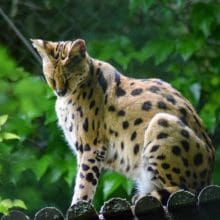Caring for Captive Cheetahs: Ensuring Their Well-being
Cheetahs are one of the most iconic and beloved animals in the world, known for their incredible speed and striking appearance. However, due to habitat loss and poaching, many cheetahs are now living in captivity in zoos and wildlife sanctuaries. As caretakers of these magnificent creatures, it is our responsibility to ensure their well-being and provide them with the best possible care. In this article, we will discuss the importance of caring for captive cheetahs and the steps that can be taken to ensure their physical and mental well-being.
Proper Nutrition and Diet for Captive Cheetahs
Cheetahs are magnificent creatures that have captured the hearts of many with their sleek bodies, powerful speed, and striking appearance. Unfortunately, due to habitat loss and poaching, the population of wild cheetahs has drastically decreased, leading to the need for captive breeding programs to ensure their survival. While these programs have been successful in increasing the cheetah population, it is crucial to ensure that these animals are well taken care of in captivity. One essential aspect of caring for captive cheetahs is providing them with proper nutrition and a balanced diet.
In the wild, cheetahs are opportunistic hunters, meaning they will prey on whatever is available in their environment. This can range from small antelopes to birds and even insects. However, in captivity, their diet is carefully planned and monitored to ensure they receive all the necessary nutrients for their well-being. A cheetah’s diet in captivity typically consists of a combination of meat, bones, and organs.
The primary source of nutrition for captive cheetahs is meat, which makes up about 90% of their diet. This meat is usually in the form of whole carcasses or chunks of muscle meat. The type of meat provided varies depending on the availability and cost, but it is essential to ensure that it is of high quality and free from any diseases. Some common types of meat fed to captive cheetahs include beef, horse, and venison.
In addition to meat, bones are also a crucial part of a cheetah’s diet. In the wild, cheetahs consume bones as a source of calcium and other essential minerals. In captivity, bones are usually fed in the form of whole carcasses or chunks of bones. These bones are essential for maintaining the cheetah’s dental health and providing them with the necessary nutrients for their bones and joints.
Organs are another vital component of a cheetah’s diet. In the wild, cheetahs consume the organs of their prey, which are rich in vitamins and minerals. In captivity, organs such as liver, kidney, and heart are fed to cheetahs to ensure they receive all the necessary nutrients for their overall health. These organs are also a great source of protein, which is essential for muscle growth and maintenance.
While meat, bones, and organs make up the majority of a cheetah’s diet, it is also essential to provide them with other supplements to ensure they receive a balanced diet. These supplements include vitamins, minerals, and fatty acids. These nutrients are crucial for a cheetah’s overall health and well-being, and their absence can lead to various health issues.
One of the challenges of providing a proper diet for captive cheetahs is replicating their natural feeding behavior. In the wild, cheetahs consume their prey whole, including bones, fur, and feathers. In captivity, these parts of the prey are usually removed, which can lead to nutritional deficiencies. To combat this, some zoos and breeding facilities have started to provide their cheetahs with whole prey, including bones, fur, and feathers. This not only ensures that the cheetahs receive all the necessary nutrients but also allows them to exhibit natural feeding behaviors.
In conclusion, proper nutrition and a balanced diet are crucial for the well-being of captive cheetahs. A diet consisting of high-quality meat, bones, organs, and supplements is essential for their overall health and to replicate their natural feeding behavior. It is the responsibility of zoos and breeding facilities to ensure that these magnificent creatures are provided with the best possible care, including a proper diet, to ensure their survival for generations to come.
Enrichment Activities for Captive Cheetahs to Promote Physical and Mental Stimulation
Cheetahs are magnificent creatures known for their speed, agility, and grace. Unfortunately, due to habitat loss and poaching, their population in the wild has drastically decreased. As a result, many cheetahs are now living in captivity, whether in zoos, sanctuaries, or private collections. While captivity may provide a safe haven for these animals, it is crucial to ensure their well-being by providing them with physical and mental stimulation through enrichment activities.
Enrichment activities are designed to mimic the natural behaviors and instincts of animals in the wild. For captive cheetahs, these activities are essential for their physical and mental health. Without proper stimulation, cheetahs can become bored, stressed, and even develop behavioral issues. Therefore, it is the responsibility of caretakers to provide a stimulating and enriching environment for these animals.
One of the most crucial aspects of enrichment for captive cheetahs is providing them with enough space to roam and run. In the wild, cheetahs can cover vast distances in search of prey. In captivity, they are confined to a limited space, which can be detrimental to their physical health. Therefore, it is essential to provide them with large enclosures that allow them to run and exercise. These enclosures should also have various terrain, such as grass, sand, and rocks, to mimic their natural habitat.
In addition to physical exercise, mental stimulation is also crucial for captive cheetahs. In the wild, cheetahs spend a significant amount of time hunting and foraging for food. In captivity, their meals are often provided for them, which can lead to boredom and lack of mental stimulation. To combat this, caretakers can use food puzzles and hiding treats around the enclosure to encourage the cheetahs to use their natural hunting instincts. This not only provides mental stimulation but also allows them to practice their natural behaviors.
Another important aspect of enrichment for captive cheetahs is providing them with opportunities to socialize. In the wild, cheetahs are solitary animals, but they do interact with other cheetahs during mating and raising cubs. In captivity, cheetahs are often housed alone, which can lead to loneliness and depression. To prevent this, caretakers can introduce cheetahs to each other gradually and monitor their interactions. If they get along, they can be housed together, providing them with companionship and social interaction.
Enrichment activities for captive cheetahs should also include opportunities for them to use their natural senses. In the wild, cheetahs rely on their keen eyesight and sense of smell to hunt and survive. In captivity, these senses are not utilized as much, which can lead to boredom and frustration. To stimulate their senses, caretakers can provide them with different scents, such as herbs and spices, and hide them around the enclosure. This encourages the cheetahs to use their sense of smell to find the treats, providing mental stimulation.
Furthermore, providing objects for the cheetahs to interact with can also be beneficial. These objects can include balls, ropes, and even cardboard boxes. Cheetahs are naturally curious animals, and these objects can pique their interest and provide them with mental stimulation. Caretakers should regularly rotate these objects to prevent boredom and keep the cheetahs engaged.
In conclusion, enrichment activities are crucial for the well-being of captive cheetahs. These activities provide physical and mental stimulation, mimic their natural behaviors, and prevent boredom and stress. Caretakers should continuously assess and improve the enrichment program to ensure the cheetahs’ needs are being met. By providing a stimulating and enriching environment, we can ensure that captive cheetahs live happy and healthy lives.
Conclusion
In conclusion, caring for captive cheetahs is crucial in ensuring their well-being. These magnificent animals require specialized care and attention to thrive in captivity. It is important for facilities housing captive cheetahs to provide proper nutrition, enrichment, and medical care to meet their physical and psychological needs. Additionally, efforts should be made to replicate their natural habitat as much as possible to promote their overall health and well-being. By prioritizing the care of captive cheetahs, we can help ensure the survival of this endangered species and provide them with a fulfilling life in captivity.
Read More About Cheetah’s From Wikipedia




